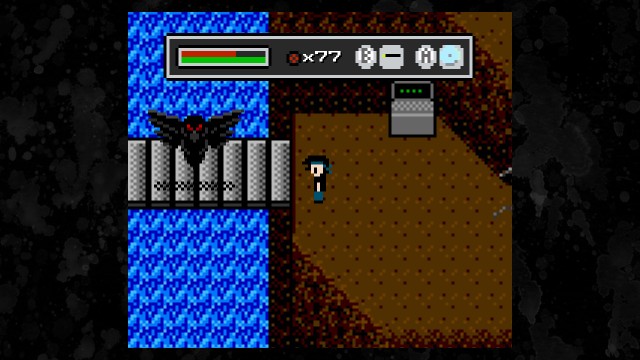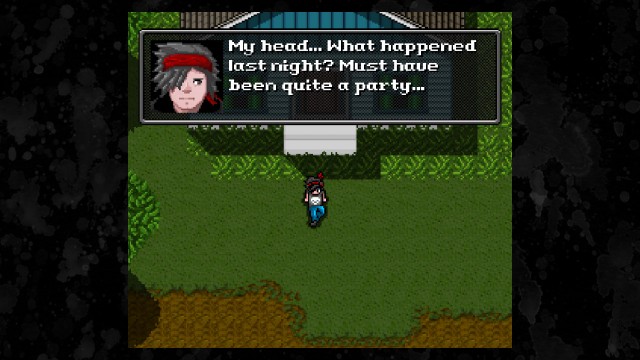First half of the game features fun and original story and gameplay ideas, great old school visuals, a truly fantastic soundtrack
The clever gameplay ideas aren't developed enough, story flat lines in the second half leading up to a disappointing conclusion, 8-bit world isn't as fun as the 16-bit world, difficulty curve doesn't rise to meet the player's abilities, and the game is short with little replay value
My first few hours with Barnyard Intelligence’s High Strangeness left me quite excited to experience the rest of the game. The story was weird and funny. The visuals captured that old-school charm. The gameplay harkened back to some of my favorite games from my youth while adding some clever new ideas. The soundtrack was phenomenal. Considering all this, it saddens me to report that a lot of that excitement was misplaced.
For the uninitiated, High Strangeness is an action-adventure indie title that brands itself as a “12-bit” game. This label comes from an important gameplay mechanic that allows the player to switch between 8-bit and 16-bit worlds at will. Aside from the aesthetic difference, the game also controls quite differently. The game wears its Zelda inspirations unabashedly for all to see, so the 8-bit world features the stiff, square-by-square movements of the original Zelda, while the 16-bit world allows for smoother traversal, very similar to A Link to the Past. Furthermore, certain enemies can only be defeated while in one world or the other and secret paths can be revealed by switching dimensions.
This is a great idea but it ultimately feels under-explored, with these same basic ideas really being the only major ways in which it is implemented. There are a few variations, but they are infrequent and not all that noteworthy. Also, the stiffer movement and combat make 8-bit world less fun to play in, so I really only ever felt compelled to use it when it was absolutely necessary. Strangely enough, one of my favorite parts of the game was an area where this ability was taken away and I had to play what was, effectively, a stealth mission that proved surprisingly fun and well crafted; I actually would have loved to see more of it.

Dimension hopping isn’t the only mechanic High Strangeness has to show for it. Further in keeping with the Zelda inspiration, the game features a host of items and abilities that serve both puzzle solving and combat purposes. Rather than having to worry about inventories and magic, everything, including your basic attacks, drains stamina, which constantly refills; so when engaged in combat you can’t just wail away at the bad guys, you can either keep your actions measured or hit and fade as you wait for your stamina to recover. Once again, we are left with a system that has a strong foundation but doesn’t really feature enough evolution over the course of the game; the combat remains simple and generally quite easy, and the puzzles don’t fully take advantage of the potential presented by your inventory. The game also allows you to use items dropped by foes to upgrade your weapons and stats, but the overall challenge never rises to the heights of your new found power, thus making the later portions of the game exceptionally easy.
This trend unfortunately continues into the game’s plot. High Strangeness starts with fun, quirky vibe as our hero, a dude named Boyd who looks like a roadie for an ’80s rock band, gets caught up in a inter-dimensional conflict involving his cat, the cute girl who works at his record store, a collection of magical crystal skulls, and an army of cloaked bad guys with mysterious motives. Early on, the writing is charming, laugh-out-loud funny and filled with plenty of video game and pop-culture references that, thankfully, lean more toward the timeless side of things. However, after a couple of hours the writing becomes quite humorless and the plot slams on the gas pedal in an effort to end as quickly as possible. A nonsensical plot twist at the end doesn’t really help the game, either. Once all was said and done, it took me less than four hours to get through the game, and as far as I can tell there really isn’t anything in the way of additional content beyond the story.

Thankfully the look and sound of High Strangeness prove to be much stronger. Both the 8- and 16-bit worlds capture the look of their respective generations quite nicely, and it is interesting to get to see everything through these different lenses. The game does feature a few too many generic brown caves, but overall it offers a decent variety of environments, though the character and enemy designs are generic but still serviceable. Some story segments feature static, watercolor artwork that is a little more hit and miss for me; some of it works just fine but there are also a few instances were the style feels at odds with the retro inspired sprite art seen throughout the rest of the game.
The soundtrack is, unequivocally, brilliant. Plenty of indie games have featured fun chiptune soundtracks but High Strangeness really is in a totally different league. The music features quite a bit of stylistic variety that really helps create a mysterious, strange atmosphere that works remarkably well for the game. No, I won’t be championing it as one of the all-time greatest soundtracks in the history of games, but it easily surpasses the vast majority of games out there and might just be my favorite so far this year.
All of these factors leave High Strangeness in a place that I find, quite appropriately, strange. Nothing about the game feels incomplete but many aspects of it feel like they weren’t fully realized. The game starts off with plenty of compelling story and gameplay ideas, but halfway through the game it feels like the developers stopped developing these ideas and then created a flat line to the end. I don’t want to make the second half of the game sound bad, because it really isn’t, but I can’t deny that it isn’t really isn’t all that good either. On the one hand, I absolutely loved my first few hours with High Strangeness, but on the other hand, I really was sorely disappointed with what was done with all the potential the game established. All things considered, I can kind of give High Strangeness a halfhearted recommendation; the soundtrack is outstanding and there are some clever story and gameplay concepts on display, just don’t be surprised if the second half leaves you feeling low.
Nintendojo was provided a copy of this game for review by a third party, though that does not affect our recommendation. For every review, Nintendojo uses a standard criteria.




 ShareThis
ShareThis






